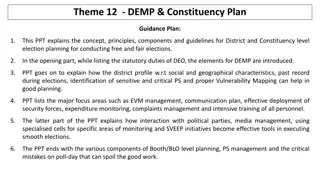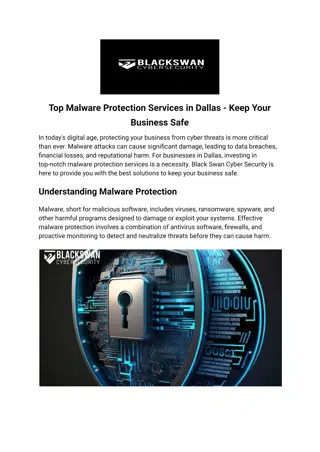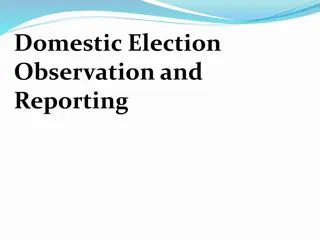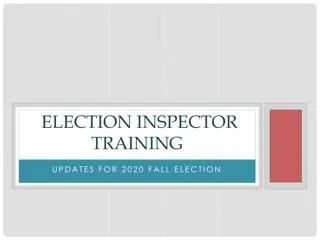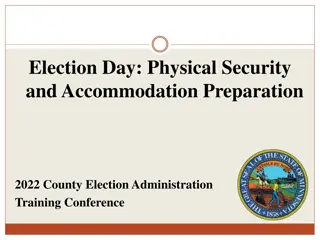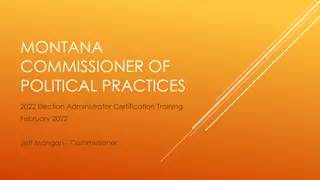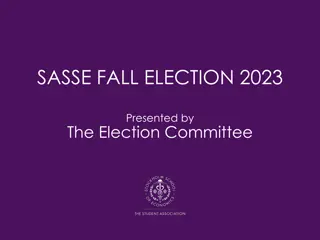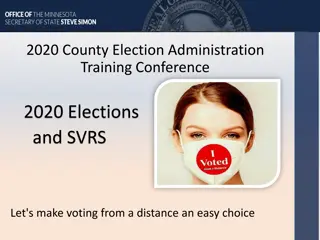Understanding and Navigating the Unpredictable: The 2020 Election Black Swan
Explore potential scenarios surrounding the 2020 elections in the face of uncertainties like political polarization and mail-in voting. Dive into the evolving landscape from Election Day to Narrow Margins in Swing States, capturing key moments and challenges. Discover insights on how to prevent or mitigate Black Swan events while observing market reactions to shifting election outcomes.
Download Presentation

Please find below an Image/Link to download the presentation.
The content on the website is provided AS IS for your information and personal use only. It may not be sold, licensed, or shared on other websites without obtaining consent from the author. Download presentation by click this link. If you encounter any issues during the download, it is possible that the publisher has removed the file from their server.
E N D
Presentation Transcript
HOW TO AVOID A BLACK SWAN IN 2020 HOW TO AVOID A BLACK SWAN IN 2020 1
The Black Swan Election The Black Swan Election A Black Swan is an unpredictable and often catastrophic event that falls outside of the boundaries of normal predictions, but that, in retrospect, can often be understood. We do not believe a Black Swan will occur in the 2020 elections, but we do believe such an event is possible given potential problems with political polarization and mail-in voting during this pandemic. In this presentation, we will consider how events could create a potential Black Swan and steps that can be taken now to prevent such events for occurring. 2
Election Day Election Day Nov 3, 2020: Election Day Donald Trump holds an 8-point lead in the popular vote. Trump leads in states with 480 Electoral Votes. According to exit polls, 81% of Trump voters have voted in person versus 31% of Biden voters. Trump declares his victory from the 18th hole at Mar-a-Lago. 3
The Blue Wave Starts The Blue Wave Starts Nov. 5, 2020 As the mail-in votes are counted, Donald Trump s lead shrinks to 3 percent. The media is calling this The Blue Wave. Donald Trump tweets, Mail-in votes are frauds. Must go with election night. Nov. 10, 2020 As mail-in counting continues, Biden takes a 1-point lead. Donald Trump says, The result of the November 3 vote will not be known for years I m not a good loser. I think mail-in voting is going to rig the election, I really do. 4
More Blue Waves + Slow Counting More Blue Waves + Slow Counting Nov 17 States continue counting mail-in votes. Joe Biden pulls ahead by 4 points in the popular vote. Trump continues to tweet about fraudulent mail-in votes. In N.Y., less than 25% of mail-in votes are counted. Rejection rates over 20%. Lawsuits brought by both parties in competitive races. Slow counting and rejection rates plague states. Millions of ballots are left to count in many states. Some states that started early, like Arizona, North Carolina, and Florida still have elections too close to call. Lawsuits filed over counting of mail-in ballots in 18 states, 11 Senate races, and 94 House of Representative elections. 5
Narrow Margins in Swing States Narrow Margins in Swing States Nov. 24, 2020 As mail-in counting continues, Biden s popular vote lead increases to 7 points. Biden leads in states with 318 electoral votes. Donald Trump says, Mail ballots, they cheat. Mail ballots are very dangerous for this country because of cheaters. They are fraudulent. Margins in swing states are very narrow: Wisconsin Biden Michigan Biden Florida Biden Pennsylvania Biden Ohio Trump Georgia Trump North Carolina Biden Arizona Biden Iowa Trump Maine #2 Biden Nebraska #2 Biden How do financial markets react? 80,000 70,000 30,000 28,000 36,000 33,000 23,000 64,000 42,000 1,000 1,000 6
Safe Harbor & Electoral College Safe Harbor & Electoral College Dec. 8: Safe Harbor Day On Dec. 8, states must attest that they have an official result. The counting is still continuing, lawsuits are filed over the election in states. Five states (Pennsylvania, Arizona, Michigan, Ohio, and Florida) begin official recounts. Dec 14: State Electoral Colleges Meet With the recounts and the lawsuits, delegations in a number of states are not able to certify the results. 7
State Legislatures & The Electoral Count Act of 1887 State Legislatures & The Electoral Count Act of 1887 Dec. 18: State Legislatures Meet States do not want to give up their Electoral College votes, so in accordance with the Electoral Count Act of 1887, State Legislatures in each of the pending States meet and appoint electors. Although Biden has a lead in 6 of the 9 states, Republican Legislatures in all of the pending states cast their votes for slates supporting Trump. Democrats in Maine cast votes for Biden in Maine #2. Republicans in Nebraska cast votes for Trump in Nebraska #2. Democratic Governors in Michigan, Wisconsin, North Carolina, and Pennsylvania appoint a separate slate of electors supporting Biden. Democrats sue to overturn the decisions of the State Legislatures, claiming the electoral votes should go to the candidate that is leading. How do financial markets react? 8
Supreme Court Supreme Court Dec 21: The Supreme Court refuses to rule on the legitimacy of the competing slates, claiming that the election rules have been determined by the 12th and 20th Amendments. If you don t know the 12th Amendment, it was ratified in 1804after the deadlocked election of 1800. Alexander Hamilton s intervention after the 35thballot, led to Jefferson s election- and ultimately to the duel with Aaron Burr that killed Hamilton. Hopefully no one, especially one of the candidates, will be killed in duels over this election, because the U.S. Constitution does not have any clear rules for succession if a candidate dies before Congress has approved the vote of the Electoral College. Dec. 23: Votes are sent to the President of the Senate, Mike Pence. 9
Joint Session of Congress Joint Session of Congress Jan. 3, 2021: The New Congress takes office. Senate races in Georgia (2), Texas, Kentucky, Iowa, Alabama, Maine, Arizona, South Carolina, Michigan, and Montana are still being challenged giving Republicans 42 seats and Democrats 46 seats, with the others still in question. Under the 17th Amendment, Governors in Montana, Iowa, Arizona, Texas, Alabama, South Carolina, and Georgia appoint Republicans to temporarily fill the Senate seats. Governors of Michigan, Maine, and Kentucky appoint Democrats. Mitch McConnell is no longer majority leader. Republicans have a 51-47 majority Democrats challenge the appointment of the Republican Senators by their states Republican governors. Democrats retain control of the House. Unlike the Senate, vacancies in the House can only be filled by special elections. 94 seats are vacant. 10
Dispute Between Senate and House Dispute Between Senate and House Jan. 6, 2021: 1:00 p.m. Mike Pence begins the count of the Electoral votes and announces that he has two sets of votes from 4 states, and that it is the responsibility of the Congress to adjudicate their validity. 4:00 P.M. The two houses of Congress separate to consider the competing slates. Republicans in the Senate approve the Trump slates, giving Donald Trump 294 electoral votes. Democrats in the House of Representatives approve the Biden slates, giving Biden 305 electoral votes. Both parties immediately challenge results in Federal court. The House of Representatives resolves to not invite the Senate back into its chambers for continuing the count until the issues related to the disputed states are resolved. 11
12 12th th Amendment Amendment Jan. 6, 2021: 1:00 P.M. With a conflict between the House and the Senate, Mike Pence instructs the House to select a President according to the rules of 12TH Amendment which states, If no person have such majority, then from the persons having the highest numbers the House of Representatives shall choose immediately, by ballot, the President. But in choosing the President, the votes shall be taken by states, the representation from each state having one vote; a quorum for this purpose shall consist of a member or members from two-thirds of the states, and a majority of all the states shall be necessary to a choice. With each state having one vote, the Republicans are in the majority. Republicans control 22 states. Democrats control 21. 7 States are either tied or, because of legal challenges, have no representation. The 22 States controlled by Republicans vote to elect Donald Trump as President. The 21 Democratic states do not vote, as to the 7 even or contested states. With only 22 states voting, a majority of the states have not voted and as a result no decision is reached. How do financial markets react? 12
Nancy Pelosi President Nancy Pelosi President Jan. 6, 2021 With neither candidate able to secure a majority of the Electoral College, Speaker of the House, Nancy Pelosi, the third in line for the Presidency, declares that she will serve as President until the election is resolved. 13
The Senate & President Mike Pence The Senate & President Mike Pence Jan. 6, 2021: The Senate meets. With Republicans filling the disputed Senate seats in Georgia (2), Texas, Iowa, Alabama, Arizona, South Carolina, Michigan, and Montana, the Senate, under the rules of the Constitution, votes to elect Mike Pence as Vice President. Democrats challenge the vote because many Senate elections are not yet resolved. Since no President has been chosen by the Electoral College, Mike Pence declares that he will serve as President elect until the election is finalized. 14
Disruption Disruption Jan 8, 2021 The Supreme Court again refuses to consider the results, claiming it is the responsibility of the Legislative Branch of government. Donald Trump protests the actions of the House calling the election the greatest fraud in U.S. history. Joe Biden says he trusts in the American system of government. The news media 24/7 on the Constitutional crisis, with each network taking expected sides and eviscerating the opposition. Protests and riots break out throughout the United States. Russia invades Latvia and Estonia. China blockades Taiwan. Turkey invades Cyprus. 15
Dispute Between Senate and House Dispute Between Senate and House Jan 11-12, 2021 In the Senate and the House of Representatives civility is almost non-existent. Representatives of both Houses of Congress accuse the other of creating a Constitutional Crisis. Donald Trump announces he will serve another term. More riots break out. 500 Americans shot. Stock markets around the world plunge. 16
National Emergencies Act & Insurrection Act National Emergencies Act & Insurrection Act Jan 13, 2021 With riots and protests erupting throughout the country, Russia invading the Baltics, and China blockading Taiwan, and Turkey invading Cyprus, Donald Trump invokes the National Emergencies Act and the Insurrection Act of 1807 and deploys both the U.S. military and the National Guard. Trump announces he will continue to serve as President until the National Emergency has ended. 17
Riots & Mayhem Riots & Mayhem Jan. 15, 2021 Protests and riots expand throughout the U.S. Democrats call Donald Trump a despot and a dictator. Trump calls Democrats thugs and accuses Schumer and Pelosi of treason. Trump mobilizes the army and the National Guard. Gun wielding militias from both sides clog streets. People remain barricaded inside their homes. FILE - People, including activists with the Boogaloo movement, rally at the State House in Concord, New Hampshire, May 2, 2020, in a protest unrelated to the George Floyd demonstrations. How do financial markets react? 18
Joe Bidens Turn Joe Biden s Turn Jan 16, 2021: As the vote counting continues, Joe Biden claims that he has won the votes of states with 304 electoral votes. With a majority of the Electoral College, he claims the Presidency. Donald Trump calls Biden s claim to the Presidency, A pitiful fraud. 19
Bipartisanship Bipartisanship Jan 17, 2021: With the stock market continuing to plunge and riots throughout the country, international crises, and four people claiming the Presidency, a bipartisan group of Senators and Congresspersons meets see if they can resolve the Constitutional crisis. This bipartisan group focuses on Section 3 of the 20th Amendment which reads, Sect. 3. The Congress may by law provide for the case wherein neither a President-elect nor a Vice President-elect shall have qualified, declaring who shall then act as President, or the manner in which one who is to act shall be selected, and such person shall act accordingly until a President or Vice President shall have qualified. Section 3 of the 20th Amendment empowers Congress to appoint a President until the election issues are resolved. The bipartisan group resolves to find someone to serve as President until the election can be resolved. 20
Bipartisan Compromise Bipartisan Compromise Jan 18, 2021: The bipartisan group considers former Presidents Clinton, Bush, and Obama, as candidates whom they believe could serve as temporary President. Clinton is eliminated because Republicans viewed his appointment as a backdoor way of installing Hillary. Obama is eliminated because Republicans considered him too polarizing. George W. Bush is selected. Republicans are willing to accept Bush rather than Biden or a former Democratic President. Democrats are willing to accept Bush as a better alternative than Trump. The Republicans then agree that Al Gore be appointed as Vice President. After the 2000 election, it is ironic that Bush and Gore would form a team. How do financial markets react? 21
The Supreme Court Rules The Supreme Court Rules Jan 19, 2021: The Supreme Court meets to consider the various challenges. Nancy Pelosi claims she should be President because no candidate reached 270 votes in the Electoral College. Mike Pence claims he should be President because the Senate elected him Vice President. Democrats object claiming the appointment of Senators by the 17th Amendment was illegal. Donald Trump claims he should remain President under the National Emergencies Act. Joe Biden claims the Presidency with 304 Electoral Votes. George W. Bush (with Al Gore as Vice President) claims he should be President under the 20th amendment. The Supreme Court considers the various arguments. Jan 20: 11:00 On January 20, at 11:00 a.m., the Supreme Court hands down its decision. 22
Jan. 20, 2021 THE PRESIDENT IS INAUGURATED Jan. 20, 2021 THE PRESIDENT IS INAUGURATED TAKE YOUR PICK 23
2022 2022- -The Election Is Over The Election Is Over Jan. 20, 2021 - April 4, 2022 Counting of mail-in ballots and legal challenges to the election continue. April 6, 2022 The Electoral College finally meets and ratifies the results of the 2020 election. April 9, 2022 Congress ratifies the 2020 election. April 20, 2022 The new President is inaugurated. How could this Constitutional crisis have occurred? 24
Polarization, Mail-in Voting, and COVID-19 Three factors contributed to this Constitutional Crisis: political polarization, which left both parties unwilling to compromise, COVID-19, and the switch to mail-in voting. Donald Trump is already signaling his 2020 strategy saying, I m not a good loser. I think mail-in voting is going to rig the election, I really do. To cause further disruption, on September 2, 2020, Trump told voters in North Carolina to vote twice- by mail and in-person. Send in your ballot and then go to the polls and vote. This is a brilliant concept, if you want to disrupt an election.If even one person who follows Trump s advice succeeds in voting twice, because of some glitch in the system, this could open a litigation can of worms unlike anything we have ever seen. It could take months, or even years, to review every ballot to ensure that people hadn t voted twice. 25
The Problem With Mail-in Voting is Infrastructure Democrats and nonpartisan experts have disputed Trump s assertions, pointing out that there is little evidence of fraud in mail-in voting. They may be correct, but: what they miss is that Some States do not have the infrastructure to handle the vast increases expected in mail-in voting. Without this infrastructure, it could take months to count ballots. Many ballots could be rejected, resulting in legal challenges. If anyone gets away with voting twice, the challenges will multiply. Final Results could be delayed until 2021 or 2022. Before going back to the Black Swan, let s take a minute to review the issues with mail-in voting. 26
Why Are Mail in Votes a Problem? Why Are Mail in Votes a Problem? There are four steps in the ballot process: 1. Sending- ballots arrive and arrive on time. 2. Securing- receiving ballots at the polling place with required postmarks. 3. Processing- checking the signature, markings, I.D.s, affidavits, etc., and approving or rejecting it. 4. Counting- tallying the accepted ballots. Logic says that mail-in votes should be easy to secure, process, and count. Many arrive early. When they arrive, people can inspect and process them. They can inform the voters if there is a problem, and then they can begin the counting. Unfortunately, State rules make securing, processing, and counting these ballots difficult, time consuming, and rife with errors. 27
Problems at the U.S.P.S. Problems at the U.S.P.S. One of the greatest concerns of mail-in voting is the mailing process itself. Ballots can be stolen out of a mailbox, lost in the mail, arrive late because of postal service delays, or, as in N.Y., be rejected because they are not postmarked. The Postmaster General has announced steps to reduce the deficit of the U.S.P.S. including: Eliminating overtime, sorting by hand, keeping mail not sorted until the next day, reducing hours for employees, and increasing the postage required for a ballot from the $0.22 business rate to $0.55. Cost cutting efforts are occurring at a time when locations are reporting substantial delays in mail delivery. In Philadelphia, some neighborhoods did not receive mail for 3 weeks. In Florida, in the Fort Myers distribution center, the number of delayed pieces increased from 186,000 in April to 5,700,000 in in August. The U.S.P.S. is warning states that there will be problems with mail-in votes. "Certain deadlines concerning mail-in ballots ., appear to be incongruous with the Postal Service's delivery standards. This mismatch creates a significant risk that some ballots will not be returned by mail in time to be counted under your laws as we understand them." 28
States Have Extended Time for Delivery States Have Extended Time for Delivery States Alaska California DC Georgia Illinois Days After Election To accommodate the problems at the U.S.P.S. states have extended the time for ballots to be received at the polling places. By allowing ballots received one to two weeks or more to be counted, as long as they are postmarked by election day, the counting of mail-in ballots will be delayed. If ballots that arrive 10, 14, or 17 days after an election will be counted, when are we going to get results? 10 17 10 3 14 Iowa Kansas 6 3 Maryland 10 Michigan 14 Minnesota Nevada New Jersey New York Ohio Pennsylvania Utah Virginia Washington W. Virginia 7 anytime 7 7 10 3 6 3 5 6 29
Postmarks Are A Problem Postmarks Are A Problem If a ballot arrives after the election, it must have a postmark if it is to be counted. This may sound like a simple issue- but it is not. In many states, like New York, ballots are sent in postage paid business reply envelopes. However, the U.S.P.S. often does not postmark these types of envelopes. This means that many votes that are sent on time will not be counted because they do not have postmarks. The fight over many of these ballots could further extend the election. States that have all mail-in voting have convenient drop boxes that help voters avoid potential U.S.P.S. issues. In Colorado, Oregon, and Washington, 2/3 of voters drop their ballots at the polling place or in a secure drop box. Most states have relatively few drop boxes and have to rely on the mail. 30
Many States Do Not Process Ballots Until Election Day Many States Do Not Process Ballots Until Election Day Processing of ballots further delays results. Even though mail-in votes may arrive early, many states do not even begin to process mail-in votes until election day. Processing may sound easy, but it is time consuming. Ballots must be opened. Postmarks, the seal on the envelope, and signatures must be checked. 4 people need to be involved. (The person opening the ballot, the person marking the tally book, and one person from each party.) This process results in two problems: It is extremely time consuming. If the ballot is rejected, there is no way to inform the voter so corrections can be made, because Election Day is well passed. Processing Mail-in Votes 12:00 E.D. Friday before Not specified 8:00 a.m. ED prior to closing of polls After election After polls close After polls close 1 pm election day election day St. election board 7 am election day 9:00 a.m. Election Day day before before election day election day Counting Mail-in Votes Polls Close Friday before Polls close After processing prior to closing of polls Wed. after After polls close After polls close After polls close After polls close St. election board 7 am election day 9:00 a,m, Election Day day before election day election day election day after close election day State Alabama Delaware DC Kentucky Louisiana Maryland Massachusetts Mississippi New Hampshire New York Oklahoma Pennsylvania South Carolina Vermont Virginia West Virginia Wisconsin idaho Michigan election day 31
Few States Begin Counting Before Election Day Few States Begin Counting Before Election Day Only 7 states (Arizona, California, Colorado, Florida, Hawaii, North Carolina, and Oregon) begin counting mail-in votes substantially before Election Day. Florida begins counting 22 days before the election, earlier than any other state. Four states (Delaware, Montana, Nebraska, and Virginia) may begin counting a day or two before. Maryland does not start counting until the day after Election Day. With the huge influx of mail-in votes expected, delaying the start of counting will delay the results. 32
Counting Mail Counting Mail- -in Votes is Very Time Consuming in Votes is Very Time Consuming As with processing, counting mail-in votes is very time consuming, again requiring 4 people. Nothing demonstrates this better than the recent N.Y. primary. In the 2020 primary were 50% of the total, compared to 2-3% in previous elections. Percentage of mail-in votes in N.Y. 2016 2018 2% 3% 2020 primary 50% John Conklin, a spokesman for the New York State Board of Elections, said the astronomically high number of absentee ballots overwhelmed a system built to handle far, far fewer . The system is built to process 3-5% . not 40-60%. (It is) not possible to change this process overnight. The N.Y. State Board of Elections admits it can t handle the election. 33
N.Y. 2020 PRIMARY N.Y. 2020 PRIMARY- -Vote Counting Troubles Vote Counting Troubles It took 6 weeks to count primary, ballots in several N.Y. Congressional Elections. If the primary took 6 weeks. If Final election turnout is 6x primary turnout. Final election results could take more than 6 weeks. Current officials resign on Jan 3, leaving seats vacant while counting continues. As the Wall Street Journal wrote, Everyone should examine New York s voting mess and then take action. . Otherwise Americans might spend Christmas wondering which self-claimed President-elect will prevail in court. 34
N.Y. 2020 PRIMARY N.Y. 2020 PRIMARY- -Rejected Votes Rejected Votes A large percentage of the mail-in ballots were rejected. In Queens, 25% of all mail-in votes were rejected. In the 12th District in Brooklyn, rejections are 28%. If 25% of all ballots are rejected, something is wrong with the system. Ballots were rejected because of: Signatures Who remembers how they signed their name when their first registered? Envelopes not sealed or sealed with tape instead of saliva. Mismarked ballots In Georgia, tens of thousands of ballots were rejected because people did not completely fill in the X s. Missing postmarks With 25% rejection rate and 50% mail-in rate, any candidate that loses an election by 20% or less will likely challenge the election in court. Challenging an election could take 8 months to more than one year. 35
Challenged Elections Over Mail Challenged Elections Over Mail- -In Votes In Votes Previous elections have been challenged over the counting of mail-in votes. In 1984 Indiana s 8th Congressional district sat empty for 4 months while courts re-qualified mail-in votes. 92 Absentee Ballots In 2008, Minnesota s Senate seat sat empty for 8 months while 6655 mail-in votes were challenged. Al Franken, who trailed after the first count, won by 225 votes. In N.Y. 14th alone, there could be more than 4x this amount. In 2018, North Carolina s 9th district sat empty for 9 months while a Republican operative was accused of ballot harvesting mail-in votes. A new election was held. In these races, there were relatively few mail-in votes. However, in a race where 25% of the mail-in votes are disqualified, there will be challenges from both parties. Each challenge could take 8 months to one year. If there are many challenges, the courts could be clogged, meaning the challenges would take a lot longer. 36
The Problems Should be Worse in States With Less Experience The Problems Should be Worse in States With Less Experience with Mail with Mail- -in Votes in Votes 9 States had less than 7% mail-in votes in 2018. These states may have issues handling the influx in 2020. Georgia had large problems with its new in-person voting system and has limited mail-in experience. Georgia has two Senate elections in 2020. Wisconsin s primary was a disaster. Wisconsin is also a swing state with a Republican Legislature and a Democratic Governor. Connecticut has no early voting, placing greater pressure on mail-in. Texas could still be a swing state, while South Carolina could have a competitive Senate race. Votes 1,421,650 3,951,876 2,335,128 3,248,642 1,200,164 389,161 1,739,705 7,976,548 2,688,341 Mail Votes Connecticut Georgia Maryland New Jersey Oklahoma Rhode Island South Carolina Texas Wisconsin 89,877 218,858 111,696 392,931 66,160 26,418 70,288 518,787 147,597 6.3% 5.5% 4.8% 6.2% 5.5% 6.8% 4.0% 6.5% 5.5% We have real concerns about these states. 37
13 States and DC Have Little Experience With Mail 13 States and DC Have Little Experience With Mail- -in Votes. in Votes. These states averaged 2.7% mail-in votes in 2018. In total, these states with 31.3 million votes had fewer mail-ins than Utah, with 1.1 million votes. Gearing up for 2020 will be a problem. Pennsylvania, North Carolina, Kentucky, Louisiana, and Massachusetts have divided governments with one party controlling the Governorship and the other party controlling the Legislature. Kentucky, Alabama, and North Carolina could have competitive Senate races. Given the limited experience with mail-in votes and N.Y. s rejection rate of 25%, many elections in these states are likely to be challenged. These states are not prepared to go from 2.7% to 50% mail- in. Votes 1,723,694 790,656 366,550 231,700 1,619,587 1,519,552 2,753,623 961,025 6,356,896 3,705,224 5,057,630 2,267,428 3,343,186 597149 Mail Votes Alabama Arkansas Delaware DC Kentucky Louisiana Massachusetts Mississippi New York North Carolina Pennsylvania Tennessee Virginia West Virginia 54,833 11,611 13,436 9,019 23,971 41,363 84,280 17,979 192,056 83,876 177,950 38,855 95,238 10,238 3.2% 1.5% 3.7% 3.9% 1.5% 2.7% 3.1% 1.9% 3.0% 2.3% 3.5% 1.7% 2.8% 1.7% 31,293,900 854,705 2.73% 38
Florida Faces Less Risk Than Most States Florida Faces Less Risk Than Most States Florida, which has lived through a number of very close elections, (2000 and 2018) is better prepared than most states for the 2020 election. Florida: Has proven adept at handling mail-in votes. In 2018, it ranked 9th among all states in the percentage of mail-in votes. (30.9%.) This should make it easier for Florida to handle increases. Allows signature verification 22 days before the election, avoiding a key bottleneck. Permits early voting 8 (or 11-15 days before Federal elections), avoiding Election Day constraints. Starts early counting 22 days before the election, the earliest of any state. Ranked #24 by the MIT Election Performance Index, one of the highest among large states. California #50, New York #49, Texas #42, Illinois #21, Pennsylvania #37 Florida registers above average in most measurements except mail ballots unreturned or rejected and military and overseas ballots unreturned or rejected. 39
Floridas Results Appear Less Partisan Than Other States Florida s Results Appear Less Partisan Than Other States All states gerrymander. In some states, gerrymandering threatens the democratic will of the voters, but Florida s results appear to be generally less partisan and more democratic than most states, especially swing states. In Wisconsin, Michigan, Pennsylvania, and North Carolina, Democrats won the majority of the vote in 2018, but Republicans won the majority of the seats in the State Legislatures. In Wisconsin, Democrats won by 8.5%, but Republicans won 65% of the seats. The same pattern applied in Congress. In Wisconsin, Democrats won by a margin of 7.5%, but received only 3 of 8 seats. In Michigan and Pennsylvania, Democratic margins were even higher, but the delegations split evenly. In North Carolina, Republicans won by 70,000 votes, but won 10 of 13 Congressional seats. Florida s results appear far more equitable. In Congress, Republicans won by 5%, despite 5 Democratic candidates running unopposed, but the seats were split 14-13. In State Senate elections, Republicans won by 8.25%, and won 14 of 20 seats. In State House of Representative elections, Republicans won by 14% and won 73 seats compared to 47. 40
9 Ways to Avoid a Constitutional Crisis 9 Ways to Avoid a Constitutional Crisis 1. Provide local convenient and secure drop boxes where voters can deposit their ballots 2. Provide extra funding for the U.S. Postal Service during the election period 3. Process mail-in votes when they are received 4. Inform people if their votes have been rejected, so they can correct their mistakes 5. Allow more early voting 6. Allow early counting of ballots 7. Hire more poll workers 8. Contact Appropriate Government Officials 9. Fix the loopholes in the Presidential election system 41
1 1- -Provide Drop Boxes Provide Drop Boxes Providing Secure and Convenient Drop Boxes for voters to deposit their ballots reduces risk of: Theft Mail loss, and Missing Postmarks There are numerous locations, including Post Offices, Police and Fire Stations, and government offices that can be used for this purpose. While States may not have time to purchase and test new voting machines, they do have time to purchase secure drop boxes, which are easily available and not expensive. 42
2 2- -Provide Extra Funding to the U.S.P.S. Provide Extra Funding to the U.S.P.S. In a year when half of all Americans want to vote by mail, it seems counter intuitive to be reducing hours and technology at the U.S. Post Office. Reducing the hours and forcing sorting by hand will delay delivery of ballots and cause more errors, such as those that have impacted N.Y. Congress is allocating more funds to help corporations and individuals hurt by the pandemic. It appears the only exception is the U.S. Postal Service. Congress should allocate more money to the U.S.P.S. so people can have confidence their votes will be delivered in a timely manner If Congress does not allocate extra funding, people should mail their votes as far ahead of Election Day as possible. 43
3 3- -Process Ballots When They Are Received Process Ballots When They Are Received Ballots should be processed when they are received. This would increase costs for added poll workers. With high unemployment, there are people available for this task. Given the potential risk, the cost is relatively small. Many states will have to immediately pass legislation allowing mail-in ballots to be processed when they are received. 44
4 4- -Inform Voters If Their Votes Have Been Rejected Inform Voters If Their Votes Have Been Rejected Only 13 states inform voters if their votes have been rejected. Failing to inform voters so they can correct their mistakes results in much higher rejection rates. Higher rejection rates result in more challenged elections. People should be informed when their votes have been rejected and given the opportunity to correct their mistakes and vote again. This will add some costs to the voting process, but it will limit claims of fraud and lawsuits. Most states will have to immediately pass legislation, as N.Y. has done, allowing the Board of Elections to inform people when their ballots have been rejected. 45
5 5- -Increase Early In Increase Early In- -Person Voting Person Voting Voters and Poll workers, many of whom are over 60, are concerned about Covid-19. States are concerned about the influx of mail-in votes. An easy solution is to provide increased in-person early voting at selected polling places. In-person early voting allows polling places to adhere to social distancing and people to cast votes without concerns for long-lines. Many will select in-person early voting instead of mail-in voting. Some states, like Connecticut, do not currently allow early in-person voting. Others, like New York, have a limited period for early in-person voting. Every State should offer 3 weeks of early in-person voting to allow people to vote safely and in-person. In most states, this will require legislation. 46
6 6- -Allow Early Counting of Ballots Allow Early Counting of Ballots States should count ballots when they are received or cast. Or, as in the case of Florida, provide a substantial period of time for early counting. Allowing early counting will remove pressure on states and avoid disputed elections. States that allow early counting have had no problems. All states should follow their lead. Allowing early counting will limit the risk of a Constitutional crisis. 47
7 7- -Hire More Poll Workers Hire More Poll Workers All states facing issues of ramping up mail-in voting should hire more poll workers to staff early voting facilities, and process and count ballots. This will add costs to the voting process. However, with the current high level of unemployment, there are plenty of people available. The costs of adding these people will be far less than the cost to the country of having a Constitutional crisis. Most states will have to allocate more funds for elections. 48
8 8- -Contact Relevant Government Officials Contact Relevant Government Officials There are two sets of government officials who should be contacted. Those responsible for running elections Those responsible for enacting legislation. In 39 states, the Secretary of State is responsible for conducting elections. A complete listing is provided on the website of the National Conference of State Legislatures. Virtually all State Legislatures have committees in their State Senates and Assemblies assigned to oversee elections and set election laws. We urge everyone to identify these government officials and communicate to them the importance of resolving election issues before we have a Constitutional crisis. 49
9 9- -Fix the Loopholes in the Election System Fix the Loopholes in the Election System We have not had a truly disputed election in the U.S. since 1876 (excluding 2000). However, there are some loopholes that could lead to the type of Black Swan event we have described. Congress should fix these loopholes so they never actually come into play. Before concluding, we could like to return to the election and tell you what to look for on election night. 50




